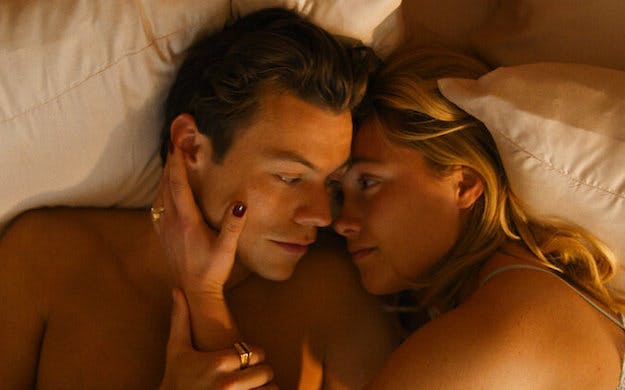‘Don’t Worry Darling’ Pulls Its Weight
Regardless of what you may have heard, it’s a serious-minded movie with an original script that deserves to be considered on its own, artful terms.

For many, the period following World War II was a “golden age” for America, and Hollywood reflects a fascination with the era by producing a seemingly continual output of entertainments in the “Mad Men” vein, featuring such signifiers as jet age idealism, square-jawed office workers, and happy homemakers. Increasingly, though, these tropes come in for deconstruction.
The new movie “Don’t Worry Darling” proposes that this time in American history was anything but golden, especially for women. Ambitious and absurd in equal measure, the movie takes place in a 1950s-style community called Victory (which looks like Palm Springs), where all the men work for the same nearby company (one with a mysterious, military-esque mission and that occasionally causes the houses to shake), and all the women stay at home to cook and clean (while always looking ravishing). Yet something is amiss: A few of the women appear disturbed or withdrawn, and this is where the movie draws its power.
The movie benefits greatly from the “force” that is Florence Pugh, as director Olivia Wilde labeled the actress. In just a few years, Ms. Pugh has accumulated an impressive list of credits, such as her Oscar-nominated performance in Greta Gerwig’s “Little Women.” As the heroine Alice in “Don’t Worry Darling,” she blasts her way through thematic provocations by grounding the character’s increasing uncertainties. It’s hard to think of another actress, except perhaps for a younger Kate Winslet, who would have excelled at making emotional, if not logical, sense of such portentous, melodramatic material.
The other actors, such as pop star Harry Styles (as Alice’s husband, Jack) and Chris Pine (as Victory’s CEO and guru, Frank), fit their parts well, though they’re not given much shading to play. While Mr. Styles seems a bit lost, he reminded this viewer of the young Elvis Presley — not in appearance but demeanor, when the early pop icon made his own tentative foray into acting.
There’s also Ms. Wilde, who acts and produces in addition to directing. As an actress, she’s fine, but it’s her work as director and producer that clues us in to her tenacious temperament and themes. Throughout “Don’t Worry,” she sprinkles in references to classics like “Brazil” and “The Truman Show,” a bold move because comparisons with these may not always turn in her movie’s favor.
The last few weeks have not been kind to “Don’t Worry”: Dogged by grim advance word, unfortunate memes, and accounts of inter-actor tensions, the movie has become something of a promotional nightmare. Regardless of what may have happened behind the scenes, though, it’s certainly a serious-minded movie with an original script that deserves to be considered on its own, artful terms.
Each of the lead crew members (and their respective departments) should be commended, including cinematographer Matthew Libatique for the intimate yet widescreen gleam of the imagery; Katie Byron for the colorful art direction and mid-century modern set design; costume designer Arianne Phillips for the alluringly retro women’s and men’s wardrobes; and composer John Powell for his unusual, effective score. Particular praise must also go to editor Affonso Gonçalves for his precision cutting — editing sometimes so searingly quick that slivers of coherence melt away before congealing in the mind.
Like an O. Henry short story with a twist ending (no spoilers ahead), Alice’s questions about where she’s living don’t get answered until near the end of the movie, though there are plenty of earlier intimations. These clues take the form of surreal interludes and moments, such as Alice cracking open fresh eggs with nothing inside them, or a Busby Berkeley-type circle of female dancers that turns into the striated iris of an eye.
One uncomfortable scene crosscuts between Mr. Styles’s character jumping and jiving in incessant rotations at a corporate function (as his boss demands him to) and Alice having a breakdown in a women’s lounge surrounded by mirrors — the concept of mise en abyme (endless abyss) as mise-en-scène.
Lapses in logic and holes in the setup persist through the movie’s final 30 minutes, but Ms. Wilde’s central theme — how male placation and female subjugation are hardwired across society — maintains its core of truth. Not everything needs to be explained or to make sense: “Don’t Worry Darling” succeeds in creating a heightened atmosphere of optimistic oppression, unsettling illusions, and acute dread. After all, irrationality can spark breakthroughs, too.

